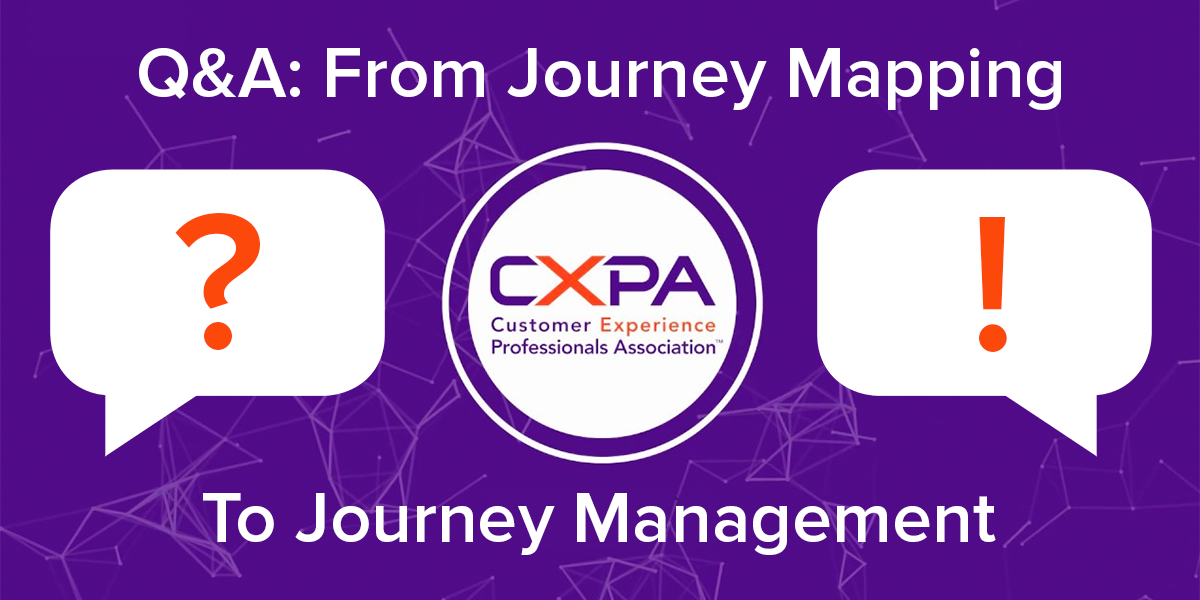On Wednesday I presented a webinar with the Toronto Customer Experience Professionals Association. We got a ton of great questions about the content I presented. So many, in fact, that I didn’t have time to answer them all on the webinar itself.
I’ve organized the questions according to the Journey Management framework that I presented on the webinar: Discover the journey, Design the journey, and Deliver the journey. I hope you’ll find the answers below helpful on your path to journey management.
Discover The Journey
Do you first have to analyze customer (quantitative) data or focus on their (qualitative) journeys?
The Holy Grail of customer research is combining quant and qual data to get the most complete picture of your customer. When starting out with your journey mapping research, I suggest following this approach: 1) Home in on interesting questions or challenges with quantitative research. 2) Dig deep into your questions with qualitative research. 3) (In)validate your new findings with quantitative research.
This approach is detailed in my blog post 3 Steps To Better Customer Research. And for more on this subject, I suggest checking out these two additional posts:
- Quant Data, Qual Data: Use Just One To Derail Your CX Efforts
- The Trade-offs Between Quant & Qual Customer Research
Can we have nested journeys?
Yes, you will definitely have different levels of zoom or altitude for your journeys. So, for example, you may have a top-level customer journey called “Go grocery shopping.” Zooming into that journey, you may find multiple sub-journeys, such as “Plan,” “Shop,” and “Put away.” And underneath the sub-journeys, you might even have micro-journeys. For the Shop sub-journey, a micro-journey during the time of COVID-19 might be “Get into the store,” which includes actions like waiting in line, putting on a mask, using hand sanitizer, and interacting with a store employee in order to get a cart or basket. (At least that’s how it works at my local store!)
If you’re creating a journey atlas, I recommend including the top two layers of journeys.
What criteria should we use to select key journeys to focus on?
The short answer is that you want to make sure the journeys you focus on are important to your customers AND to your organization. The longer answer is that you should choose a journey that:
- Is causing pain for your target customers.
- Is causing pain for your organization.
- Has enough complexity to warrant journey mapping.
- Zeroes in on a specific goal, task or challenge for your customers with a defined beginning and end.
You can find more on each of these four criteria in my blog post Which Customer Journeys Should You Map?
Can you give some examples of identifying a journey in the telecommunications industry?
Sure! I think Comcast Xfinity has done a great job of identifying what it calls its six master journeys: Join, Pay, Enjoy, Problem, Change, and Leave.
Design The Journey
Would you use or start with data/feedback/research from customers when designing the journey?
Absolutely. That’s why Design comes after Discover in my journey management framework!You need to understand your customers’ needs and expectations as completely as possible before you start making decisions about what you should change about the experience. Otherwise, you’ll be shooting in the dark.
What would you say is the difference in the user experience (UX) approach vs. the customer experience (CX) approach?
These two functions are related in that they’re both focused on creating more effective customer interactions. UX folks are generally focused on designing specific digital touchpoints, like a website or a mobile app. In contrast, CX professionals look broadly across all channels—websites, mobile apps, email, online chat, phone conversations, retail store visits, home visits from technicians, paper statements, and so on. They regularly, not occasionally, look beyond digital.
Here are a couple of oldie-but-goodie articles I wrote for UX Magazine on the relationship between UX and CX:
And if you prefer video format, you can get a lot of the same info in my WebVisions talk, From User Experience To Customer Experience.
Deliver The Journey
If we implement the “Centralized Journey Governance” model, should this be a cross-functional team or forum?
Yes. The idea behind journey management is that it brings together disparate silos that don’t often communicate or collaborate — or, at least, don’t do those activities well. So, any journey management you do should include employees from multiple functions, channels, lines of business, etc.
Should the “Journey Manager” be a specialist CX person or a businessperson (a specialist in the area of that journey)?
CX generalists are good fits for journey manager roles, as these professionals are accustomed to learning about new areas of the business and already have a CX toolkit to apply to their work. A businessperson would also work — as long as they’re able to let go of what they know about all the inner workings of the business and put themselves in the mind of the customer.
Should Product Managers be appointed Journey Managers?
In my mental model of the ideal journey manager — if such a person actually exists — they use all the hard and soft skills of product management, just applied to customer journeys instead of products. So, yes, I think existing product managers would be fantastic candidates for journey management positions.
Does anything change with your recommended approach to journey delivery for a start-up or small business vs. a large organization?
I think of journey management as an accordion. When fully extended, you complete all of the journey management activities in a methodical way. When compressed, you adopt the key elements of the journey mindset, and then do what you can with the resources available to you.
For example, a start-up or small business may not have the budget to hire a dedicated journey manager. But they can still create a journey atlas, map key customer journeys, and examine key business metrics in the context of those journeys.
Like exercising, doing something (anything!) is MUCH better than doing nothing at all.
How would you calculate the health of the journey as a whole?
Start with surveying customers to get their feedback about key journeys. For this, you’ll need to use care when crafting your questions to make sure the customer knows you’re asking about the entire journey, and not just a particular interaction.
Over time, you can create a blended metric that includes additional customer feedback data (about particular touchpoints), outcome data (like renewals), financial data (like sales), and operational data (like call center volume). Keep in mind that while you should strive to have a common method of determining the health score, the equation for these blended metrics will vary based on the journey you’re measuring. For example, it probably doesn’t make sense to include sales figures in a customer support journey, and the touchpoints you ask about will change from journey to journey.
This article was originally published at https://kerrybodine.com/.






